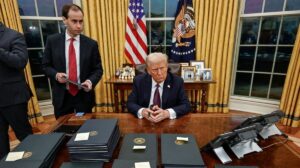In a move to streamline governance, President Trump has mandated federal agencies to repeal regulations conflicting with recent Supreme Court rulings, utilizing expedited processes and focusing on anticompetitive regulations to foster a more competitive economy.
Trump Directs Federal Agencies to Repeal Unlawful Regulations Following Supreme Court Rulings

Trump Directs Federal Agencies to Repeal Unlawful Regulations Following Supreme Court Rulings
President Trump reinforces the alignment of federal regulations with Supreme Court decisions through a new memorandum aimed at enhancing governmental efficiency.
Article Text:
In a strategic initiative to refine federal governance, President Donald J. Trump has unveiled a Presidential Memorandum that instructs all executive departments and agencies to identify and repeal regulations considered unlawful according to ten recent pivotal Supreme Court rulings. This new directive is an extension of Executive Order 14219, “Ensuring Lawful Governance and Implementing the President’s ‘Department Of Government Efficiency’ Deregulatory Initiative,” which was enacted on February 19, 2025.
The memorandum underscores the critical need for agencies to adjust their regulatory practices in alignment with the constitutional standards reinforced by the Supreme Court. Key rulings, including West Virginia v. EPA, Loper Bright Enterprises v. Raimondo, and SEC v. Jarkesy, have limited broad interpretations of agency powers, highlighting the essentiality of compliance with legislative requirements.
To expedite this regulatory rollback, the memorandum permits agencies to invoke the “good cause” exception under the Administrative Procedure Act (APA), thus allowing them to bypass the conventional notice-and-comment rulemaking process when revoking regulations that clash with the aforementioned Supreme Court decisions. This mechanism is designed to efficiently eliminate unlawful regulations and reduce bureaucratic inertia.
Additionally, President Trump has instructed the Federal Trade Commission (FTC) to lead a government-wide initiative aimed at rescinding or amending federal regulations that impede competition, entrepreneurship, and innovation. This directive is comprehensive, covering a broad scope of federal regulations that may carry anticompetitive ramifications, ultimately striving for a more vibrant and competitive economic landscape.
Federal agencies are now charged with a 60-day timeframe to evaluate existing regulations against the backdrop of the specified Supreme Court rulings. Following this assessment, they are expected to swiftly repeal or adjust regulations that surpass statutory authority or are classified as unlawful. This concerted endeavor demonstrates the administration’s dedication to ensuring federal regulations function within the scope of constitutional and legislative guidelines.
President Trump’s memorandum represents a notable transformation in federal regulatory practices, aiming to bolster the rule of law by aligning agency operations with recent Supreme Court decisions while accelerating the repeal of illegitimate regulations. Through this approach, the administration seeks to cultivate a more accountable and constitutionally founded federal bureaucracy.
In a strategic initiative to refine federal governance, President Donald J. Trump has unveiled a Presidential Memorandum that instructs all executive departments and agencies to identify and repeal regulations considered unlawful according to ten recent pivotal Supreme Court rulings. This new directive is an extension of Executive Order 14219, “Ensuring Lawful Governance and Implementing the President’s ‘Department Of Government Efficiency’ Deregulatory Initiative,” which was enacted on February 19, 2025.
The memorandum underscores the critical need for agencies to adjust their regulatory practices in alignment with the constitutional standards reinforced by the Supreme Court. Key rulings, including West Virginia v. EPA, Loper Bright Enterprises v. Raimondo, and SEC v. Jarkesy, have limited broad interpretations of agency powers, highlighting the essentiality of compliance with legislative requirements.
To expedite this regulatory rollback, the memorandum permits agencies to invoke the “good cause” exception under the Administrative Procedure Act (APA), thus allowing them to bypass the conventional notice-and-comment rulemaking process when revoking regulations that clash with the aforementioned Supreme Court decisions. This mechanism is designed to efficiently eliminate unlawful regulations and reduce bureaucratic inertia.
Additionally, President Trump has instructed the Federal Trade Commission (FTC) to lead a government-wide initiative aimed at rescinding or amending federal regulations that impede competition, entrepreneurship, and innovation. This directive is comprehensive, covering a broad scope of federal regulations that may carry anticompetitive ramifications, ultimately striving for a more vibrant and competitive economic landscape.
Federal agencies are now charged with a 60-day timeframe to evaluate existing regulations against the backdrop of the specified Supreme Court rulings. Following this assessment, they are expected to swiftly repeal or adjust regulations that surpass statutory authority or are classified as unlawful. This concerted endeavor demonstrates the administration’s dedication to ensuring federal regulations function within the scope of constitutional and legislative guidelines.
President Trump’s memorandum represents a notable transformation in federal regulatory practices, aiming to bolster the rule of law by aligning agency operations with recent Supreme Court decisions while accelerating the repeal of illegitimate regulations. Through this approach, the administration seeks to cultivate a more accountable and constitutionally founded federal bureaucracy.























